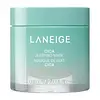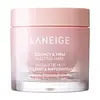What's inside
What's inside
 Key Ingredients
Key Ingredients

 Benefits
Benefits

 Concerns
Concerns

 Ingredients Side-by-side
Ingredients Side-by-side

Water
Skin ConditioningGlycerin
HumectantSqualane
EmollientButylene Glycol
HumectantCetearyl Alcohol
EmollientDicaprylyl Carbonate
Emollient1,2-Hexanediol
Skin ConditioningButylene Glycol Dicaprylate/Dicaprate
EmollientPentaerythrityl Tetraethylhexanoate
EmollientPolyglyceryl-3 Methylglucose Distearate
EmulsifyingHydrogenated Coco-Glycerides
EmollientPolyglyceryl-3 Distearate
EmulsifyingGlyceryl Stearate
EmollientPanthenol
Skin ConditioningAmmonium Acryloyldimethyltaurate/Vp Copolymer
Cetearyl Glucoside
EmulsifyingLactobacillus Ferment
Skin ConditioningPolyacrylate Crosspolymer-6
Emulsion StabilisingLactobacillus Ferment Lysate
Skin ConditioningPropanediol
SolventNiacinamide
SmoothingEthylhexylglycerin
Skin ConditioningGlyceryl Stearate Citrate
EmollientAllantoin
Skin ConditioningSodium Stearoyl Glutamate
CleansingDipotassium Glycyrrhizate
HumectantSodium Metaphosphate
BufferingMadecassoside
AntioxidantEctoin
Skin ConditioningDextrin
AbsorbentTheobroma Cacao Extract
Skin ConditioningBeta-Glucan
Skin ConditioningAsiaticoside
AntioxidantMadecassic Acid
Skin ConditioningAsiatic Acid
Skin ConditioningTocopherol
AntioxidantCentella Asiatica Flower/Leaf/Stem Extract
Skin ConditioningHydrolyzed Vegetable Protein
Skin Conditioning7-Dehydrocholesterol
Emulsion StabilisingInonotus Obliquus Extract
Skin ConditioningWater, Glycerin, Squalane, Butylene Glycol, Cetearyl Alcohol, Dicaprylyl Carbonate, 1,2-Hexanediol, Butylene Glycol Dicaprylate/Dicaprate, Pentaerythrityl Tetraethylhexanoate, Polyglyceryl-3 Methylglucose Distearate, Hydrogenated Coco-Glycerides, Polyglyceryl-3 Distearate, Glyceryl Stearate, Panthenol, Ammonium Acryloyldimethyltaurate/Vp Copolymer, Cetearyl Glucoside, Lactobacillus Ferment, Polyacrylate Crosspolymer-6, Lactobacillus Ferment Lysate, Propanediol, Niacinamide, Ethylhexylglycerin, Glyceryl Stearate Citrate, Allantoin, Sodium Stearoyl Glutamate, Dipotassium Glycyrrhizate, Sodium Metaphosphate, Madecassoside, Ectoin, Dextrin, Theobroma Cacao Extract, Beta-Glucan, Asiaticoside, Madecassic Acid, Asiatic Acid, Tocopherol, Centella Asiatica Flower/Leaf/Stem Extract, Hydrolyzed Vegetable Protein, 7-Dehydrocholesterol, Inonotus Obliquus Extract
Water
Skin ConditioningButylene Glycol
HumectantGlycerin
HumectantDimethicone
Emollient1,2-Hexanediol
Skin ConditioningSqualane
EmollientDiisostearyl Malate
EmollientC12-16 Alcohols
EmollientAmmonium Acryloyldimethyltaurate/Beheneth-25 Methacrylate Crosspolymer
Emulsion StabilisingCetearyl Alcohol
EmollientPalmitic Acid
EmollientHydrogenated Lecithin
EmulsifyingDimethicone/Vinyl Dimethicone Crosspolymer
Skin ConditioningSodium Polyacrylate Starch
AbsorbentStearic Acid
CleansingHydroxypropyl Bispalmitamide Mea
EmollientMannitol
HumectantLactobacillus Ferment Lysate
Skin ConditioningPropanediol
SolventAmmonium Acryloyldimethyltaurate/Vp Copolymer
Cetearyl Glucoside
EmulsifyingXanthan Gum
EmulsifyingGlyceryl Caprylate
EmollientDisodium EDTA
Ethylhexylglycerin
Skin ConditioningAllantoin
Skin ConditioningAdenosine
Skin ConditioningParfum
MaskingAcrylates/Ammonium Methacrylate Copolymer
Caprylyl Glycol
EmollientCarbomer
Emulsion StabilisingCholesterol
EmollientLinalool
PerfumingSilica
AbrasiveMalachite Extract
AntioxidantCitronellol
PerfumingGeraniol
PerfumingHydroxycitronellal
PerfumingCarthamus Tinctorius Flower Extract
Skin ConditioningDextrin
AbsorbentBenzyl Salicylate
PerfumingCyanocobalamin
Skin ConditioningHydrolyzed Collagen
EmollientSodium Hyaluronate
HumectantPaeonia Albiflora Root Extract
Skin ConditioningTocopherol
AntioxidantHydrolyzed Hyaluronic Acid
HumectantAcetyl Tetrapeptide-2
Skin ConditioningSodium Hyaluronate Crosspolymer
HumectantHyaluronic Acid
HumectantPaeonia Albiflora Flower Extract
TonicSodium Acetylated Hyaluronate
HumectantWater, Butylene Glycol, Glycerin, Dimethicone, 1,2-Hexanediol, Squalane, Diisostearyl Malate, C12-16 Alcohols, Ammonium Acryloyldimethyltaurate/Beheneth-25 Methacrylate Crosspolymer, Cetearyl Alcohol, Palmitic Acid, Hydrogenated Lecithin, Dimethicone/Vinyl Dimethicone Crosspolymer, Sodium Polyacrylate Starch, Stearic Acid, Hydroxypropyl Bispalmitamide Mea, Mannitol, Lactobacillus Ferment Lysate, Propanediol, Ammonium Acryloyldimethyltaurate/Vp Copolymer, Cetearyl Glucoside, Xanthan Gum, Glyceryl Caprylate, Disodium EDTA, Ethylhexylglycerin, Allantoin, Adenosine, Parfum, Acrylates/Ammonium Methacrylate Copolymer, Caprylyl Glycol, Carbomer, Cholesterol, Linalool, Silica, Malachite Extract, Citronellol, Geraniol, Hydroxycitronellal, Carthamus Tinctorius Flower Extract, Dextrin, Benzyl Salicylate, Cyanocobalamin, Hydrolyzed Collagen, Sodium Hyaluronate, Paeonia Albiflora Root Extract, Tocopherol, Hydrolyzed Hyaluronic Acid, Acetyl Tetrapeptide-2, Sodium Hyaluronate Crosspolymer, Hyaluronic Acid, Paeonia Albiflora Flower Extract, Sodium Acetylated Hyaluronate
 Reviews
Reviews

Ingredients Explained
These ingredients are found in both products.
Ingredients higher up in an ingredient list are typically present in a larger amount.
1,2-Hexanediol is a synthetic liquid and another multi-functional powerhouse.
It is a:
- Humectant, drawing moisture into the skin
- Emollient, helping to soften skin
- Solvent, dispersing and stabilizing formulas
- Preservative booster, enhancing the antimicrobial activity of other preservatives
Allantoin is a soothing ingredient known for its protective and moisturizingg properties. Because of this, it is often added to products with strong active ingredients.
Studies show higher concentrations of this ingredient can promote wound healing.
Though it can be derived from the comfrey plant, allantoin is produced synthetically for cosmetic products to ensure purity.
Learn more about AllantoinAmmonium Acryloyldimethyltaurate/Vp Copolymer (let's call it AAVC for short) is a synthetically created polymer. It's used as a film-forming agent and used to thicken the consistency of products.
AAVC is able to increase the consistency and viscosity of products due to its large molecule size. It also prevents ingredients from separating.
Butylene Glycol (or BG) is used within cosmetic products for a few different reasons:
Overall, Butylene Glycol is a safe and well-rounded ingredient that works well with other ingredients.
Though this ingredient works well with most skin types, some people with sensitive skin may experience a reaction such as allergic rashes, closed comedones, or itchiness.
Learn more about Butylene GlycolCetearyl alcohol is a mixture of two fatty alcohols: cetyl alcohol and stearyl alcohol. It is mainly used as an emulsifier. Emulsifiers help prevent the separation of oils and products. Due to its composition, it can also be used to thicken a product or help create foam.
Cetearyl alcohol is an emollient. Emollients help soothe and hydrate the skin by trapping moisture.
Studies show Cetearyl alcohol is non-toxic and non-irritating. The FDA allows products labeled "alcohol-free" to have fatty alcohols.
This ingredient is usually derived from plant oils such as palm, vegetable, or coconut oils. There is debate on whether this ingredient will cause acne.
Due to the fatty acid base, this ingredient may not be Malassezia folliculitis safe.
Learn more about Cetearyl AlcoholCetearyl Glucoside is a surfactant and emulsifier. It can be produced from synthetic of natural sources of cetearyl alcohol and glucose.
Emulsifiers help prevent ingredients from separating, such as oils and waters. It can also be used to enhance the texture of products.
As a surfactant, Cetearyl Glucoside helps during the cleansing process. By gathering all the dirt and oils, it allows these molecules to be washed away easily.
Learn more about Cetearyl GlucosideDextrin is used to thicken a product and helps bind ingredients together. It is created from starch and glycogen.
As an emulsifier, dextrin prevents ingredients from separating. This helps elongate a product's shelf life.
Studies show coating UV filters with dextrin prevents these ingredients from being absorbed. This helps UV ingredients last longer on the skin.
Learn more about DextrinEthylhexylglycerin (we can't pronounce this either) is commonly used as a preservative and skin softener. It is derived from glyceryl.
You might see Ethylhexylglycerin often paired with other preservatives such as phenoxyethanol. Ethylhexylglycerin has been found to increase the effectiveness of these other preservatives.
Glycerin is already naturally found in your skin. It helps moisturize and protect your skin.
A study from 2016 found glycerin to be more effective as a humectant than AHAs and hyaluronic acid.
As a humectant, it helps the skin stay hydrated by pulling moisture to your skin. The low molecular weight of glycerin allows it to pull moisture into the deeper layers of your skin.
Hydrated skin improves your skin barrier; Your skin barrier helps protect against irritants and bacteria.
Glycerin has also been found to have antimicrobial and antiviral properties. Due to these properties, glycerin is often used in wound and burn treatments.
In cosmetics, glycerin is usually derived from plants such as soybean or palm. However, it can also be sourced from animals, such as tallow or animal fat.
This ingredient is organic, colorless, odorless, and non-toxic.
Glycerin is the name for this ingredient in American English. British English uses Glycerol/Glycerine.
Learn more about GlycerinLactobacillus Ferment Lysate is a postbiotic with skin soothing properties. Postbiotics are inactive molecules produced by probiotic bacteria that provide skin benefits.
This ingredient comes from the secretion of the bacteria, Lactobacillus.
Studies show this ingredient can help calm redness and may help treat the signs of photoaging; however, the evidence is inconclusive and further studies are needed.
Learn more about Lactobacillus Ferment LysatePropanediol is an all-star ingredient. It softens, hydrates, and smooths the skin.
It’s often used to:
Propanediol is not likely to cause sensitivity and considered safe to use. It is derived from corn or petroleum with a clear color and no scent.
Learn more about PropanediolSqualane is an emollient that helps the skin hold onto moisture. It's an oily liquid that occurs naturally in certain types of fish and plant oils.
Because squalane boosts hydration in the skin, it also comes with plenty of benefits: it is an antioxidant and can help fight free radicals and skin damage. Squalane is also found to have a detoxifying effect when applied.
Squalane comes from squalene, which occurs naturally within the sebum of our skin. It is one of the oils our skin produces to keep itself hydrated. Squalane is the hydrogenated version of squalene and has a longer shelf life.
Research shows that squalane is non-irritating (even at 100% concentration).
In general, it's a fantastic ingredient. It does a great job at hydrating the skin, and it's suitable for those with sensitive skin.
The source of squalane may impact malassezia / fungal acne. This is because olive oil derived squalane can contain impurities such as fatty acids and plant waxes. Sugarcane derived squalane is recommended for anyone with malassezia concerns.
Is squalane vegan?
This depends on the source. Squalane can be derived from both plants and animals. Most squalane used in skincare comes from plants.
Please note: the source of squalane is only known if disclosed by the brand. We recommend reaching out to the brand if you have any questions about their squalane.
Read more about squalene with an "e".
Is squalane an oil?
Squalane is often called an oil, but it’s technically not; it’s a hydrocarbon, meaning it’s only made of carbon and hydrogen, unlike true oils which are triglycerides made of fatty acids and glycerol.
The term “oil-free” isn’t regulated, so companies can define it however they want. Some exclude all oils, while others just avoid mineral oil or comedogenic oils.
While some people avoid oils thinking they cause breakouts, the right kind of oil (or oil-like ingredient like squalane) can actually help balance and hydrate your skin. It’s worth testing out simple oils or squalane to see what works best for your skin.
Learn more about SqualaneTocopherol (also known as Vitamin E) is a common antioxidant used to help protect the skin from free-radicals and strengthen the skin barrier. It's also fat soluble - this means our skin is great at absorbing it.
Vitamin E also helps keep your natural skin lipids healthy. Your lipid skin barrier naturally consists of lipids, ceramides, and fatty acids. Vitamin E offers extra protection for your skin’s lipid barrier, keeping your skin healthy and nourished.
Another benefit is a bit of UV protection. Vitamin E helps reduce the damage caused by UVB rays. (It should not replace your sunscreen). Combining it with Vitamin C can decrease sunburned cells and hyperpigmentation after UV exposure.
You might have noticed Vitamin E + C often paired together. This is because it is great at stabilizing Vitamin C. Using the two together helps increase the effectiveness of both ingredients.
There are often claims that Vitamin E can reduce/prevent scarring, but these claims haven't been confirmed by scientific research.
Learn more about TocopherolWater. It's the most common cosmetic ingredient of all. You'll usually see it at the top of ingredient lists, meaning that it makes up the largest part of the product.
So why is it so popular? Water most often acts as a solvent - this means that it helps dissolve other ingredients into the formulation.
You'll also recognize water as that liquid we all need to stay alive. If you see this, drink a glass of water. Stay hydrated!
Learn more about Water